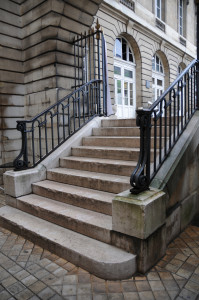
One of the icons of Paris and probably one of the first stops for a first-time visitor is Notre-Dame de Paris (Our Lady of Paris) or simply, Notre-Dame. It is located on the Île de la Cité, an island in the Seine, and the historic center of the city. What you see is a beautiful and clean gothic cathedral standing in this marvelous public square. The sun shines down on you and you can see both the Right and Left Banks on opposite sides of the Seine. You can move around relatively easily on either side of the ancient street that bisects the island from north to south: Boulevard du Justice. Prior to 1858, none of this was true.
Medieval Île de la Cité
During the time Notre-Dame was being constructed (1163–1345) the island was a maze of densely populated working-class houses, churches (twenty-seven of them), and narrow, muddy, winding streets. A new east-west road had to be built (c. 1160) to reach the front of Notre-Dame to allow for delivery of construction materials. It was the widest road in Paris at that time: 16 feet. Read More Gargoyles and Grotesques


